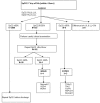Accuracy of pulse oximetry screening for detecting critical congenital heart disease in the newborns in rural hospital of Central India
- PMID: 26236364
- PMCID: PMC4521327
Accuracy of pulse oximetry screening for detecting critical congenital heart disease in the newborns in rural hospital of Central India
Abstract
Background: Congenital cardiovascular malformations are the most common category of birth defects and responsible for mortality in the first twelve months of life. Critical congenital heart disease (CCHD) will be present in approximately one quarter of these children, which requires catheter or surgery intervention in the first year of life.
Aim: To determine the accuracy of pulse oximetry for detecting clinically unrecognized CCHD in the newborns.
Methods: Pulse oximetry was performed on clinically normal newborns within first 4 hours of life. If screening oxygen saturation (SpO2) was below 90%, echocardiography was then performed.
Inclusion criteria: All newborns who were admitted in postnatal ward & NICU.
Exclusion criteria: Out born babies and babies with a prenatal diagnosis of duct dependent circulation.
Results: Pulse-oximetric screening was performed on 2110 clinically normal newborns. Low SpO2 (<90%) was found in eight babies seven of them had CCHD, including three neonates with TGA, two with tricuspid atresia, one with tetralogy of fallot and one with transposition of great vessels. A pulse oximetry cut-off value of below 90% for detecting CCHD showed 100% sensitivity, 99.95% specificity, 87.50% positive predictive value, 100% negative predictive value.
Conclusions: Pulse oximetry is safe, feasible and noninvasive, can be used as screening tool for detecting CCHD in clinically normal newborn. If SpO2 is below 90% in clinically normal newborns within 4 hours of birth, urgent echocardiography is suggested to rule out CCHD.
Keywords: Critical; Heart defect; Newborn; Pulse Oximetry; Screening.
References
-
- de Wahl Granelli A, Mellander M, Sunnegårdh J, Sandberg K, Ostman-Smith I. Screening for duct-dependant congenital heart disease with pulse oximetry: a critical evaluation of strategies to maximize sensitivity. Acta Paediatr 2005;94:1590–6. - PubMed
-
- Knowles R, Griebsch I, Dezateux C, Brown J, Bull C, Wren CN. Newborn screening for congenital heart defects: a systematic review and cost-effectiveness analysis. Health Technol Assess 2005;9:1–168. - PubMed
-
- Meberg A, Otterstad JE, Frøland G, Hals J, Sörland SJ. Early clinical screening for congenital heart disease: the cases we miss. Cardiol Young 1999;9:169–74. - PubMed
-
- Arlettaz R, Bauschatz AS, Mönkhoff M, Essers B, Bauersfeld U. The contribution of pulse oximetry to the early detection of congenital heart disease in newborns. Eur J Pediatr 2006;165:94–8. - PubMed
LinkOut - more resources
Full Text Sources

